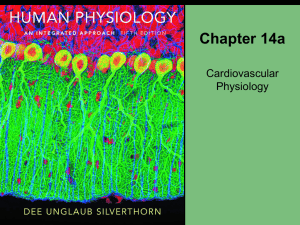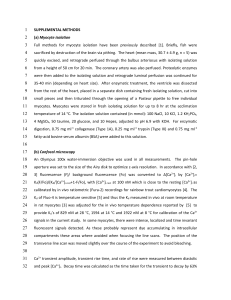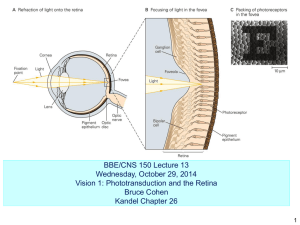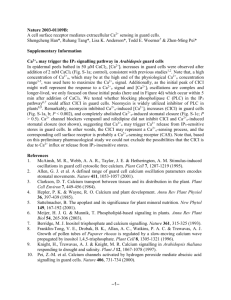Geert Bultynck, PhD
advertisement
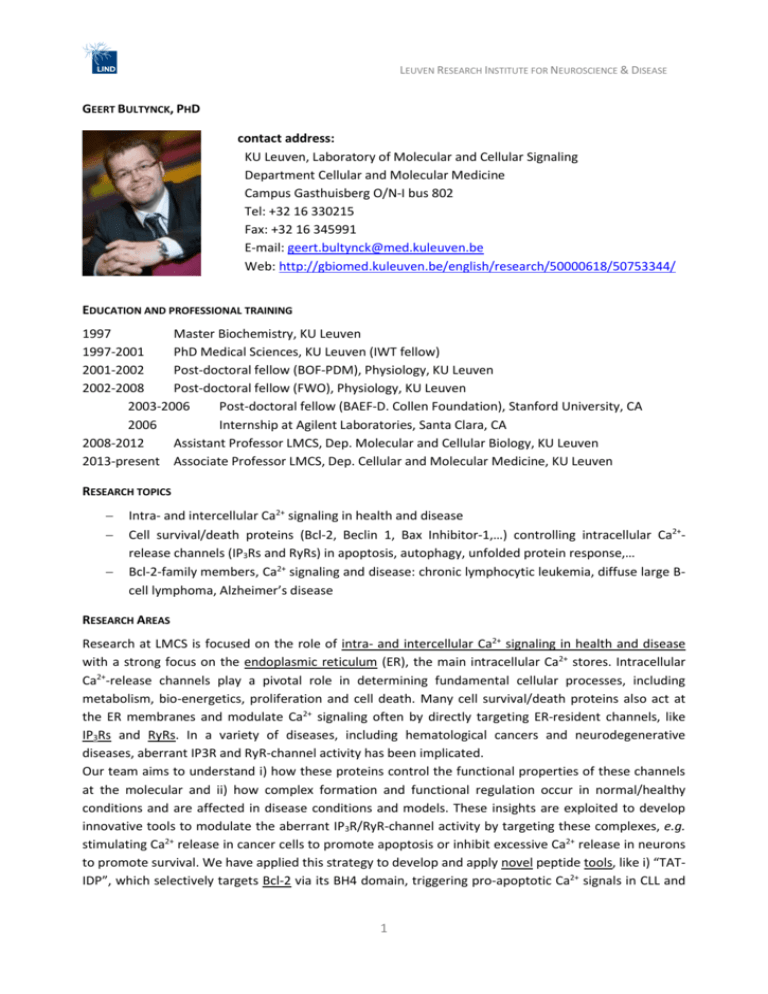
LEUVEN RESEARCH INSTITUTE FOR NEUROSCIENCE & DISEASE GEERT BULTYNCK, PHD contact address: KU Leuven, Laboratory of Molecular and Cellular Signaling Department Cellular and Molecular Medicine Campus Gasthuisberg O/N-I bus 802 Tel: +32 16 330215 Fax: +32 16 345991 E-mail: geert.bultynck@med.kuleuven.be Web: http://gbiomed.kuleuven.be/english/research/50000618/50753344/ EDUCATION AND PROFESSIONAL TRAINING 1997 Master Biochemistry, KU Leuven 1997-2001 PhD Medical Sciences, KU Leuven (IWT fellow) 2001-2002 Post-doctoral fellow (BOF-PDM), Physiology, KU Leuven 2002-2008 Post-doctoral fellow (FWO), Physiology, KU Leuven 2003-2006 Post-doctoral fellow (BAEF-D. Collen Foundation), Stanford University, CA 2006 Internship at Agilent Laboratories, Santa Clara, CA 2008-2012 Assistant Professor LMCS, Dep. Molecular and Cellular Biology, KU Leuven 2013-present Associate Professor LMCS, Dep. Cellular and Molecular Medicine, KU Leuven RESEARCH TOPICS Intra- and intercellular Ca2+ signaling in health and disease Cell survival/death proteins (Bcl-2, Beclin 1, Bax Inhibitor-1,…) controlling intracellular Ca2+release channels (IP3Rs and RyRs) in apoptosis, autophagy, unfolded protein response,… Bcl-2-family members, Ca2+ signaling and disease: chronic lymphocytic leukemia, diffuse large Bcell lymphoma, Alzheimer’s disease RESEARCH AREAS Research at LMCS is focused on the role of intra- and intercellular Ca2+ signaling in health and disease with a strong focus on the endoplasmic reticulum (ER), the main intracellular Ca2+ stores. Intracellular Ca2+-release channels play a pivotal role in determining fundamental cellular processes, including metabolism, bio-energetics, proliferation and cell death. Many cell survival/death proteins also act at the ER membranes and modulate Ca2+ signaling often by directly targeting ER-resident channels, like IP3Rs and RyRs. In a variety of diseases, including hematological cancers and neurodegenerative diseases, aberrant IP3R and RyR-channel activity has been implicated. Our team aims to understand i) how these proteins control the functional properties of these channels at the molecular and ii) how complex formation and functional regulation occur in normal/healthy conditions and are affected in disease conditions and models. These insights are exploited to develop innovative tools to modulate the aberrant IP3R/RyR-channel activity by targeting these complexes, e.g. stimulating Ca2+ release in cancer cells to promote apoptosis or inhibit excessive Ca2+ release in neurons to promote survival. We have applied this strategy to develop and apply novel peptide tools, like i) “TATIDP”, which selectively targets Bcl-2 via its BH4 domain, triggering pro-apoptotic Ca2+ signals in CLL and 1 LEUVEN RESEARCH INSTITUTE FOR NEUROSCIENCE & DISEASE DL-BCL but not in normal lymphocytes and ii) “TAT-L2”, which selectively inhibits Cx43 hemichannels but not gap junctions, erasing fear memory consolidation upon injection in the basal amygdala. Finally, our team has a keen interest in assessing the “Ca2+-signaling profile” of a variety of pharmacological tools with a focus on anti-cancer drugs, but suggestions by others and collaborative projects are warmly welcomed. In particular, disturbing intracellular Ca2+-homeostasis or dynamics may be a “toxic” side effect or may actually contribute to the mode of action of the drugs. Hence, pharmacological compounds are assessed in a standardized work flow using permeabilized cells single cells and cell populations (including plasmalemmal Ca2+ fluxes), thereby providing integrated insights on their effect on ER Ca2+ uptake, ER Ca2+ leak, IP3-induced Ca2+ release in unidirectional Ca2+-flux conditions and on plasmalemmal Ca2+ fluxes, including store-operated Ca2+ influx. For these studies, we make use of different molecular, biophysical and cellular approaches (including SPR, pull-downs, Ca2+ imaging in single cells and cell populations, 45Ca2+ fluxes, confocal microscopy, cytometry-based analysis). MAJOR SCIENTIFIC AWARDS - FK506 Award (Fujisawa GmbH, Munchen, Germany), 2001 - Physiology Award (Royal Academy for Medicine of Belgium), 2003 - Octaaf Dupont Award (Royal Flemish Academy of Belgium for Science), 2010 - J.B. Van Helmont Award for pathophysiology (Royal Academy for Medicine of Belgium), 2011 - Best Talk at the Signal Transduction Society meeting (Weimar, Germany), 2012 - Galenus Award for fundamental pharmacology (ActuaMedica/Artsenkrant), 2013 SELECTED PUBLICATION 1. Jensen LE, Bultynck G, Luyten T, Amijee H, Bootman MD, Roderick HL. (2013) Alzheimer's diseaseassociated peptide Aβ42 mobilizes ER Ca2+ via InsP3R-dependent and -independent mechanisms. Frontiers in Molecular Neuroscience. 6:36. (PMID: 24204331) 2. Akl H, Bultynck G. (2013) Altered Ca2+ signaling in cancer cells: proto-oncogenes and tumor suppressors targeting IP3 receptors. Biochim Biophys Acta - Reviews on Cancer. 1835(2):180-93. (PMID: 23232185) 3. Akl H, Monaco G, La Rovere R, Welkenhuyzen K, Kiviluoto S, Vervliet T, Molgó J, Distelhorst CW, Missiaen L, Mikoshiba K, Parys JB, De Smedt H, Bultynck G. (2013) IP3R2 levels dictate the apoptotic sensitivity of diffuse large B-cell lymphoma cells to an IP3R-derived peptide targeting the BH4 domain of Bcl-2. Cell Death and Disease. 4:e632. (PMID: 23681227) 4. Monaco G, Decrock E, Akl H, Ponsaerts R, Vervliet T, Luyten T, De Maeyer M, Missiaen L, Distelhorst CW, De Smedt H, Parys JB, Leybaert L, Bultynck G. (2012) Selective regulation of IP3-receptormediated Ca2+ signaling and apoptosis by the BH4 domain of Bcl-2 versus Bcl-Xl. Cell Death and Differentiation. 19(2):295-309. (PMID: 2181811) Faculty of 1000. 5. Decuypere JP, Welkenhuyzen K, Luyten T, Ponsaerts R, Dewaele M, Molgó J, Agostinis P, Missiaen L, De Smedt H, Parys JB, Bultynck G. (2011) Ins(1,4,5)P3 receptor-mediated Ca2+ signaling and autophagy induction are interrelated. Autophagy. 7(12):1472-89. (PMID: 2208287) Faculty of 1000. 6. Ponsaerts R, De Vuyst E, Retamal M, D'hondt C, Vermeire D, Wang N, De Smedt H, Zimmermann P, Himpens B, Vereecke J, Leybaert L, Bultynck G. (2010) Intramolecular loop/tail interactions are essential for connexin 43-hemichannel activity. FASEB Journal. 24(11):4378-95. (PMID: 2063435) Faculty of 1000. 2
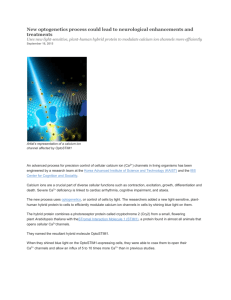
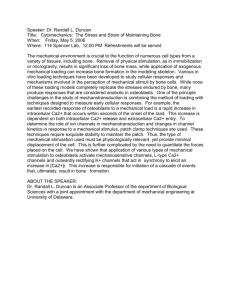
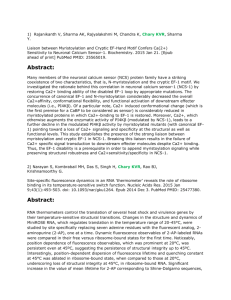
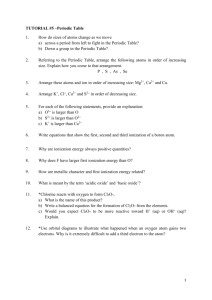
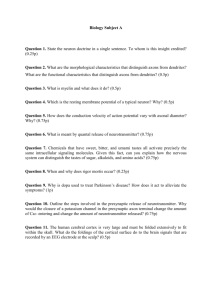
![Substantiation of the Rhod-2 as indicator of cytosolic [Ca2+] Rhod](http://s3.studylib.net/store/data/006893824_1-225923ad9f8cdb438dcdcf307ccbe9bd-300x300.png)
